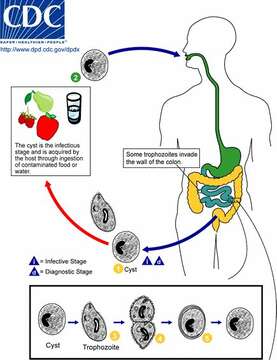Life cycle of Balantidium coli, the cause of human balantidiasis

Açıklama:
Life cycle of Balantidium coli, the cause of human balantidiasis
The cyst stage (1) of the B. coli life cycle is responsible for transmission.The host most often acquires the cyst through ingestion of contaminated food or water (2). Following ingestion, excystation occurs in the small intestine and the trophozoites colonize the large intestine (3). The trophozoites reside in the lumen of the large intestine of humans and other animals, where they reproduce by binary fission, during which conjugation may occur (4). Trophozoites undergo encystation to produce infective cysts (5). Some trophozoites invade the wall of the colon and multiply. Some return to the lumen and disintegrate. Mature cysts are passed with feces (1).
From Centers for Disease Control Parasites and Health website
Aşağıdaki Sayfalarda Bulunmaktadır:
- Life
- Cellular
- Eukaryota (Ökaryot)
- SAR (Stramenopiles, Alveolates, Rhizaria)
- Alveolata
- Ciliophora (Silliler)
- Intramacronucleata
- Litostomatea
- Trichostomatia
- Vestibuliferida
- Balantidiidae
- Balantidium
- Balantidium coli
Bu resim hiçbir koleksiyonda yer almıyor.
Kaynak Bilgileri
- lisans
- cc-by-nc
- telif hakkı
- Centers for Disease Control/Division of Parasitic Diseases and Malaria
- yayıncı
- Shapiro, Leo
- fotoğrafçı
- Centers for Disease Control/Division of Parasitic Diseases and Malaria
- sağlayıcı
- EOL Rapid Response Team
- orijinal
- orijinal medya dosyası
- kaynağı ziyaret et
- ortak site
- EOL staff
- ID


